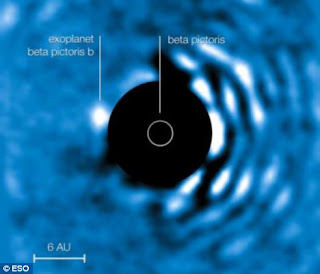 Astronomers have developed a way to see planets previously hidden in their star's glare. The breakthrough will enables scientists to search for planets that are much closer to the star than has been previously possible. It makes it far more likely that Earth-like planets could be found close to stars in distant galaxies. Using new optics technology an international team of astronomers has obtained images of a planet on a much closer orbit around its parent star than any other extrasolar planet previously found. The discovery was published online in Astrophysical Journal Letters. Installed on the European Southern Observatory's Very Large Telescope, or VLT, atop Paranal Mountain in Chile, the new technology enabled an international team of astronomers to confirm the existence and orbital movement of a new planet. Beta Pictoris b is a planet about seven to 10 times the mass of Jupiter, around its parent star, Beta Pictoris, 63 light years away. The system works by using a small piece of glass with a complex pattern etched onto its surface. This Apodizing Phase Plate (APP) blocks out the starlight in a certain way, allowing planets to show up in the image whose signals were previously drowned out by the star's glare. (Daily Mail)
Astronomers have developed a way to see planets previously hidden in their star's glare. The breakthrough will enables scientists to search for planets that are much closer to the star than has been previously possible. It makes it far more likely that Earth-like planets could be found close to stars in distant galaxies. Using new optics technology an international team of astronomers has obtained images of a planet on a much closer orbit around its parent star than any other extrasolar planet previously found. The discovery was published online in Astrophysical Journal Letters. Installed on the European Southern Observatory's Very Large Telescope, or VLT, atop Paranal Mountain in Chile, the new technology enabled an international team of astronomers to confirm the existence and orbital movement of a new planet. Beta Pictoris b is a planet about seven to 10 times the mass of Jupiter, around its parent star, Beta Pictoris, 63 light years away. The system works by using a small piece of glass with a complex pattern etched onto its surface. This Apodizing Phase Plate (APP) blocks out the starlight in a certain way, allowing planets to show up in the image whose signals were previously drowned out by the star's glare. (Daily Mail)Welcome to "A Light In The Darkness" - a realm that explores the mysterious and the occult; the paranormal and the supernatural; the unexplained and the controversial; and, not forgetting, of course, the conspiracy theories; including Artificial Intelligence; Chemtrails and Geo-engineering; 5G and EMR Hazards; The Net Zero lie ; Trans-Humanism and Trans-Genderism; The Covid-19 and mRNA vaccine issues; The Ukraine Deception ... and a whole lot more.
Further Reading
▼
Monday, 18 October 2010
Astronomers discover new way of spotting planets that were hidden in their star's glare
 Astronomers have developed a way to see planets previously hidden in their star's glare. The breakthrough will enables scientists to search for planets that are much closer to the star than has been previously possible. It makes it far more likely that Earth-like planets could be found close to stars in distant galaxies. Using new optics technology an international team of astronomers has obtained images of a planet on a much closer orbit around its parent star than any other extrasolar planet previously found. The discovery was published online in Astrophysical Journal Letters. Installed on the European Southern Observatory's Very Large Telescope, or VLT, atop Paranal Mountain in Chile, the new technology enabled an international team of astronomers to confirm the existence and orbital movement of a new planet. Beta Pictoris b is a planet about seven to 10 times the mass of Jupiter, around its parent star, Beta Pictoris, 63 light years away. The system works by using a small piece of glass with a complex pattern etched onto its surface. This Apodizing Phase Plate (APP) blocks out the starlight in a certain way, allowing planets to show up in the image whose signals were previously drowned out by the star's glare. (Daily Mail)
Astronomers have developed a way to see planets previously hidden in their star's glare. The breakthrough will enables scientists to search for planets that are much closer to the star than has been previously possible. It makes it far more likely that Earth-like planets could be found close to stars in distant galaxies. Using new optics technology an international team of astronomers has obtained images of a planet on a much closer orbit around its parent star than any other extrasolar planet previously found. The discovery was published online in Astrophysical Journal Letters. Installed on the European Southern Observatory's Very Large Telescope, or VLT, atop Paranal Mountain in Chile, the new technology enabled an international team of astronomers to confirm the existence and orbital movement of a new planet. Beta Pictoris b is a planet about seven to 10 times the mass of Jupiter, around its parent star, Beta Pictoris, 63 light years away. The system works by using a small piece of glass with a complex pattern etched onto its surface. This Apodizing Phase Plate (APP) blocks out the starlight in a certain way, allowing planets to show up in the image whose signals were previously drowned out by the star's glare. (Daily Mail)